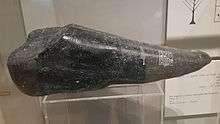Durand Stone

The Durand Stone is an artifact in Bahrain dating back to the Kassite period. Named after Captain Edward Law Durand who had first identified it, the stone is a 25-30 cm wide and 70-80 cm long black basalt sculpture in the shape of a prow of a boat or an animal's tongue, with a cuneiform inscription.[1]
Contents
The inscription, in Old Babylonian cuneiform script, was translated by Henry Rawlinson to read: "The palace of Rimum, servant of (the god) Enzak, (and) man of (the tribe of) Agarum".[1] Inzak, son of Enki, was a principal god of Bahrain, and the Durand Stone provides archaeological evidence for identifying these islands as 'the abode of the blessed' of Dilmun referred to by Sumerian literature.[2]
History
Originally housed in the "holy of holies" of the Madrasseh-i Daood mosque (now destroyed) in Bilad Al Qadeem,[1] it was spotted in 1878 by Captain Edward Law Durand (first-assistant resident to the Persian Gulf Residency), who tricked the mullahs into releasing it to him by telling them it was a fire-worshipper's stone and therefore unIslamic.[3] The stone itself, a diorite, is believed to originate from Oman or southeastern Iran. [1]
The contents of the inscription helped archaeologists conclude that Bahrain was the location of the Dilmun civilisation.[4]
Today
According to the records of Charles Belgrave, he states the Durand Stone was destroyed during the Second World War.[1] A replica of the Durand Stone lies in the Bahrain National Museum.[5]
References
- 1 2 3 4 5 Insoll, Timothy (2013). Land Of Enki In The Islamic Era. Routledge. ISBN 9781136774973.
- ↑ Rawlinson, H. (1880). "Notes on Capt. Durand's Report upon the Islands of Bahrain". JRAS. 12: 14–40.
- ↑ Safar, F.; et al. (1981). Eridu. p. 44.
- ↑ Rice, Michael (2002). The Archaeology of the Arabian Gulf. Routledge. p. 25. ISBN 9781134967933.
- ↑ "Spotlight on Bahrain". Food and Travel. Retrieved 18 July 2015. External link in
|website=(help)